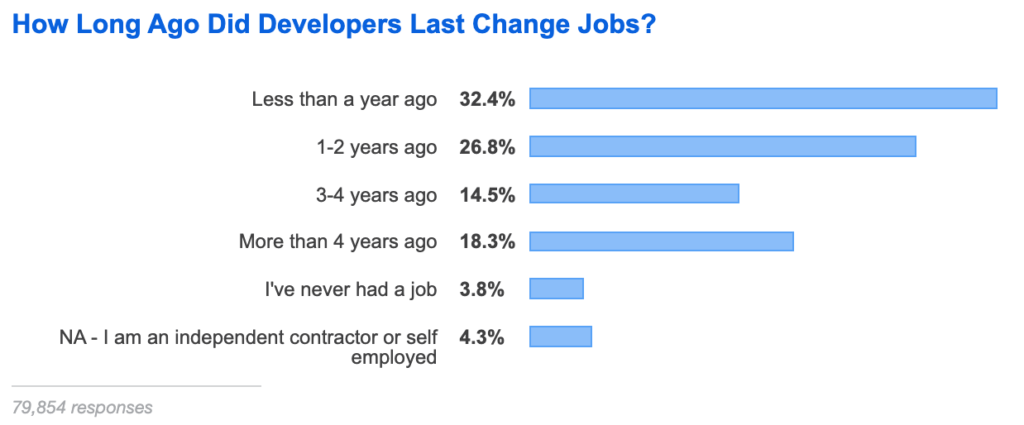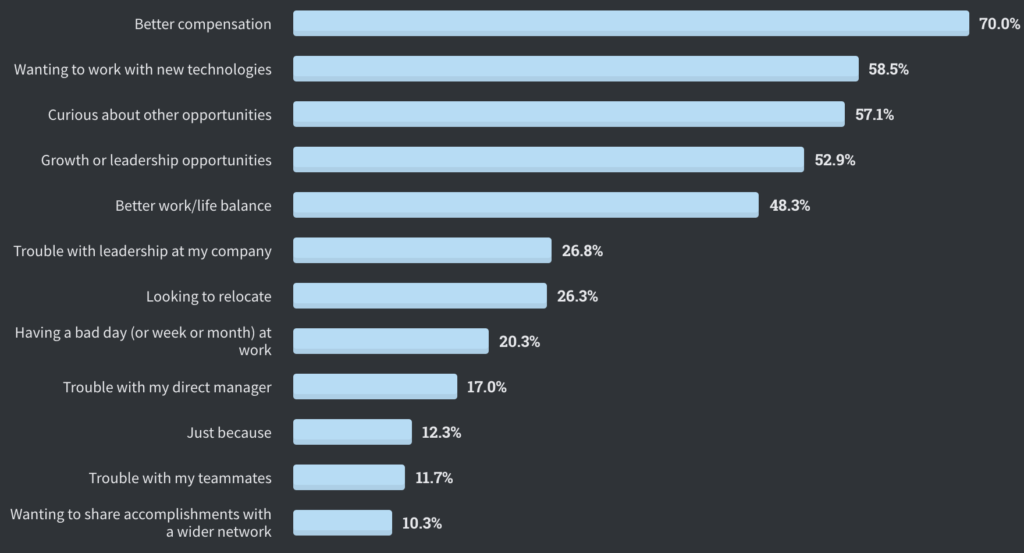
Why is employee retention important and how to improve it [updated for 2022]

Finding and hiring the top talent in tech is tough. However, so is employee retention. According to a survey conducted by SHRM, 47% of HR professionals consider employee retention a top workforce management challenge. It’s more efficient and cost-effective to retain employees than it is to source, recruit, and onboard a replacement employee of the same quality, so knowing how to improve employee retention should be a huge part of your recruitment process. In this article, you’ll learn why employee retention is important as well as discover some of the best strategies on how to retain employees effectively.
Employee retention definition
To make sure we’re all on the same page, let’s start off with a definition of employee retention.
Employee retention is an organization’s ability to prevent its employees from leaving. While it can be represented in a statistical form, many view it as the company’s efforts to retain its workforce.

Fonte: Unsplash
Retaining employees, particularly in the tech industry where opportunities are everywhere, is not easy. While it might sound surprising at first, employee retention starts at the hiring stage.
Namely, the more effort you put into recruiting new employees with the right skills and right fit to your company culture, the fewer issues with employee attrition you will have in the future. We’ll explore this topic in detail later in this post.
Why employee retention is important – especially in tech
So, why is employee retention important?
1. To maintain high team morale and employee satisfaction
If for any reason, employees are unsatisfied with their current careers or employer, it will be apparent to the rest of the team. Furthermore, if many of your employees start leaving the organization within a short timeframe, it might lead to a snowball effect, i.e. more team members following in their footsteps. As a result, team morale will plummet and it will endanger your business stability.
It’s important to engage both old and new employees in your company culture. Particularly now that so many companies have remote employees, it’s very easy for employees to feel distanced from the team. Work social events are a great way to encourage employee engagement. Events, where all your employees are made to feel included, are perfect to boost employee retention and overall job satisfaction.
2. High employee turnover impacts the bottom line
According to the Work Institute, the cost of employee turnover is equal to a third of the worker’s annual salary. However, these costs are significantly higher in tech. In fact, on average, it costs a whopping $87k to replace a developer. These costs relate to processes such as recruitment, compensation, productivity loss, and your new hires’ onboarding and training.
Overall, it’s more cost-effective to create and execute an employee retention plan than it is to replace your team members.
3. Developers can switch jobs easily
De acordo com Stack Overflow research, 32.4% of developers change jobs more than once a year. If you do not prove to your employees that you appreciate their work and care about their professional development, you risk losing them to a different company. Bear in mind that, on average, it takes 43 days to hire a developer. If you’re hiring for a very specific niche or a rare skill, this time can be significantly longer.

Fonte: Stack Overflow
4. A-players care about their development
One of the most important criteria for deciding which company to join is professional development opportunities. This is especially true when it comes to the best programmers, who are ambitious and fast learners. In fact, 70% of employees are likely to leave their employer to join a company known for employee development and learning. By using a tool like TalentBoost, which we mention further in this article, you can keep track of employee career paths and prevent them from leaving.
5. Your competitors can benefit
Losing employees can be painful, not only because it’s both costly and time-consuming to find a replacement, but also because they can switch sides and join the competition. The knowledge they acquired while working for you can end up in the wrong hands and significantly benefit your business rivals. It’s particularly risky when your key employees leave – by the time you hire someone matching their skillset, the workload will grow and it might be hard to catch up.
6. It could harm your reputation
High employee turnover and an inability to retain talent, not only leads to lower employee morale, but it can also negatively impact your reputation outside of the company. It’s common practice to seek information about your potential employers on portals like Glassdooror RateMyEmployer. Chances are that those who leave might write you a negative review. Even if they don’t, a lot of reviews appearing on your profile within a short timeframe will still indicate high turnover. This, in turn, might harm your future recruitment efforts – just imagine getting a review like the one below!

Fonte: Vacancy Filler
Drivers of staff retention
Before we discuss team retention techniques, let us take a look at what drives employee retention.
Fostering fulfillment
Did you know that only 49% of Americans are fully satisfied with their jobs?
People choose particular careers for a reason – some love the hype around building new products, while others get excited by drawing graphs in Excel. Whatever the reason, doing a job that brings satisfaction plays a crucial role in employee engagement. Your employees must feel their work is both valued and appreciated.
Providing growth opportunities
According to Udemy, 42% of employees in the US say expanding their skillsis a top priority when choosing an employer.
Human brains are programmed to seek and learn new things – it’s called the “seeking system”. According to the Professor of Organizational Behaviour, Daniel M. Cable, “our seeking systems create the natural impulse to explore our worlds, learn about our environments, and extract meaning from our circumstances. When we follow the urges of our seeking system, it releases dopamine—a neurotransmitter linked to motivation and pleasure—that makes us want to explore more”.
If employers want to keep their talent engaged they must be able to provide them with continuous growth opportunities. One of the ways this can be done is by helping people understand and pursue their potential. Employers can help people achieve this by identifying the skills they already have, and those which are missing or can be improved. Identifying these skills can be done with talent management solutions like TalentBoost.

Fonte:TalentBoost
Enable autonomy
Trust your employees to make their own decisions, and avoid micromanagement; after all, you’ve hired the best employees, so let them do their job. As said by Tom Ridge, “you have to enable and empower people to make decisions independent of you. As I’ve learned, each person on a team is an extension of your leadership; if they feel empowered by you they will magnify your power to lead”.
Facilitate collaboration
If you value talent retention, you should make sure that your employees know how to work effectively together. This can mean anything from removing silos between teams (for instance, designers and developers), knowing whom to reach out to with specific questions, all the way to helping your employees to get to know one another. As aptly noticed in a piece by Forbes Coaches Council, “socialization needs to be a continuous process and is paramount for the ultimate success of the business.” Encouraging your employees to collaborate will increase employee engagement by making the new employee feel more confident in their role.
Introduce structured processes and workflows
Employees might be frustrated if there aren’t any guidelines or processes set for their day-to-day work. To increase your employee retention rate, you must make it easy for your team to perform their work and find the necessary information and answers to their questions. You should, for instance, make sure that your tech team has access to a knowledge base and establish an agile workflow.
Keep your tech stack relevant
To boost tech staff retention, you should make sure that your company’s tech stack isn’t falling behind. Namely, the ability to work with new technologies is the second most important factor developers look for in a job, just right after compensation. Moreover, if your company adjusts its tech stack to the newest standards and trends, you will also be able to attract more talented, motivated hires.

Fonte: Stack Overflow
10 Employee retention strategies
Before we start discussing employee retention strategies, it’s worth emphasizing that retaining people starts with hiring the right people. Therefore, it should be a conscious, planned effort across the whole employee lifecycle.
However, it’s no good bringing in the right people, if you can’t keep them. You need to do all you can to make your best employees feel valued. Some companies introduce entire employee retention programs, but even without this, there are several simple steps you can take to make sure your best employees decide to stay.
You need to make sure they are part of your company culture in order to reduce employee turnover. Here are some of our best employee retention strategies:
1. Hire selectively
Not all candidates who apply for the job are a perfect match. Avoid hiring underqualified as well as overqualified candidates. Both scenarios will most probably lead to them leaving your organization. To ensure that your candidates are the right fit, you should accurately verify their skills through a technical skill assessment with a solution like TalentScore. Using a talent management platform like TalentBoost will in turn help you identify and map the skills gaps, as well as decide on how to close them.
2. Offer training
Employee burnout is often cited as a big reason for companies not being able to retain their staff. Employee dissatisfaction can start at any level and is something you need to be aware of. You can combat this by offering melhoria de competências e requalificação opportunities where older employees can get a new lease of life, and even a new career path, within your company by learning new skills. Engaged employees are those who feel their contribution to your company is valued.
The best tech employees care about good career growth opportunities. They prioritize learning new skills, which will help them advance in their careers. Introduce gestão de competências tools and systems that let your employees know your company cares about their ongoing education and encourages them to develop.
3. Recognize accomplishments and offer promotion
O most effective leaders realize that to build an engaged workplace it’s necessary for employees to feel understood and appreciated. We all like hearing from time to time that we did a good job. It’s crucial to acknowledge successes, as it keeps employees motivated. It will also benefit you if you spot employees due for promotions, instead of waiting for them to approach you.
4. Be open and transparent
Open communication between employees and management can contribute to creating a sense of community and a shared purpose. Your employees should know that they can freely express their opinions, whatever they are, and that their voices will be heard and taken into account.
Encourage employees to provide feedback. You can do this using employee surveys. Highly engaged employees are likely to care about the direction of the company. You can even get feedback from a departing employee, regardless of the reasons why they are leaving. Exit interviews can be very useful as the employee has nothing to lose, and so you will likely receive some very honest comments that you can use to improve. You can then use this feedback to try to get make future employees stay on longer.
5. Use technology to measure employee engagement
It’s good practice to regularly measure employee engagement – as mentioned above, you can send out surveys anonymously if required. A low employee engagement score might trigger a red light. If you realize a problem soon enough, you might be able to prevent an employee exodus and boost your employee retention rate.

Fonte: Unsplash
6. Run annual performance reviews
Performing a thorough annual performance review is another important employee retention technique. By conducting a yearly review, you’ll be able to learn about your employees’ satisfaction levels, find out whether there are any challenges or problems they’re struggling with, and discuss your employees’ and organizations’ long-term and short-term goals. For the best results, consider supporting annual reviews with more frequent feedback sessions.,
7. Maintain a healthy work-life balance
Assigning too much work to your employee will frequently lead to frustration and burnout. This may not only result in a massive productivity loss but also the employee leaving your organization. Respecting your employees’ free time and providing them with a flexible vacation policy will have a certain positive impact on your staff retention. Another thing you can do is offer your developers the option to work from home or choose their working hours. Both of these factors are extremely important to the tech workforce.
8. Offer competitive compensation
An employee’s annual salary is a huge factor in how content they will be at your company. According to Stack Overflow’s 2020 study, 70% of tech professionals state that competitive pay is the most important factor they pay attention to when considering a new job. Therefore, offering your current employees a competitive salary is necessary to prevent them from leaving. It doesn’t guarantee that they’ll stay, but at least they’ll have one less reason to leave.
9. Bonding with employees
As humans, we value our connections with others – both in our private and professional lives. As it’s harder to leave a company if the employees bond with one another and their managers, your retention technique should also focus on team integration.
10. Conducting exit interviews
Last, but not least, while you won’t be able to prevent all of your employees from leaving, once they hand in their resignation, you should make sure to collect feedback for your company. Schedule an exit interview and try to understand their motivation. For instance, are they quitting because they’re relocating, want to gain experience in a new industry, or maybe there’s an issue within your organization? Being aware of the reasons why team members quit will help you fix any problems and strengthen your employee retention strategy over time.
Summary
In recent years, the competition for IT talent has become extremely high, with companies from all over the globe constantly fighting for tech professionals’ attention. If your organization lacks the right employee retention strategy, chances are your team members won’t think twice if approached with the right offer, and will decide to leave you.
Luckily, there are ways in which you can keep your employees and boost their work satisfaction levels. Among others, you should make sure to bond with your team, respect their work-life balance, conduct annual performance reviews, as well as use the right tools to measure their engagement levels. Follow the techniques discussed above, and you’ll be better prepared to retain your tech talent and make your company a great place to work.
Good luck!
Crédito da imagem: Unsplash




